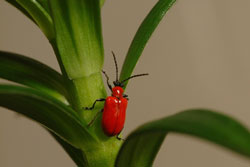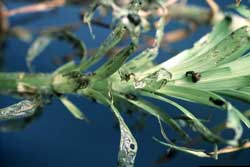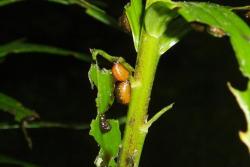Lily Leaf Beetle—Lilioceris lilii
The lily leaf beetle is an invasive species that dines on and destroys ornamental lily plants. Both adults and larvae do serious damage to plants. Adult beetles overwinter in the soil or plant debris in the garden or woods, sometimes a distance away from the host plants. Adults prefer environments that are shaded, protected, cool, and moist.
Lily leaf beetles will taste or feed lightly on many plants including Lilium spp., Fritillaria spp., Polygonatum spp. (Solomon's seal), Solanum dulcamara (bittersweet nightshade), S. tuberosum (potato), Smilax spp., Nicotiana spp. and other plants. However, they will only lay eggs and develop on Liliuim species (Turk's cap lilies, tiger lilies, Easter lilies, Asiatic and Oriental lilies), and species of Fritillaria.
Click on images to view full-size
Identification and Control Information
- Lily Leaf Beetle—UMass Amherst Agriculture & Landscape Program
- Fact Sheet: Lily Leaf Beetle—University of Maine Cooperative Extension
- Tips for Managing Lily Leaf Beetles (PDF)—Maine Integrated Pest Management Council
- Lily Leaf Beetle Larval Collections 2014—University of Rhode Island College of the Environment and Life Sciences
- Lily Leaf Beetle (PDF)—University of New Hampshire Cooperative Extension
[Photos, left to right: Lisa Tewksbury, University of Rhode Island, Bugwood.org; Richard A. Casagrande, University of Rhode Island, Bugwood.org; Leslie J. Mehrhoff, University of Connecticut, Bugwood.org]


